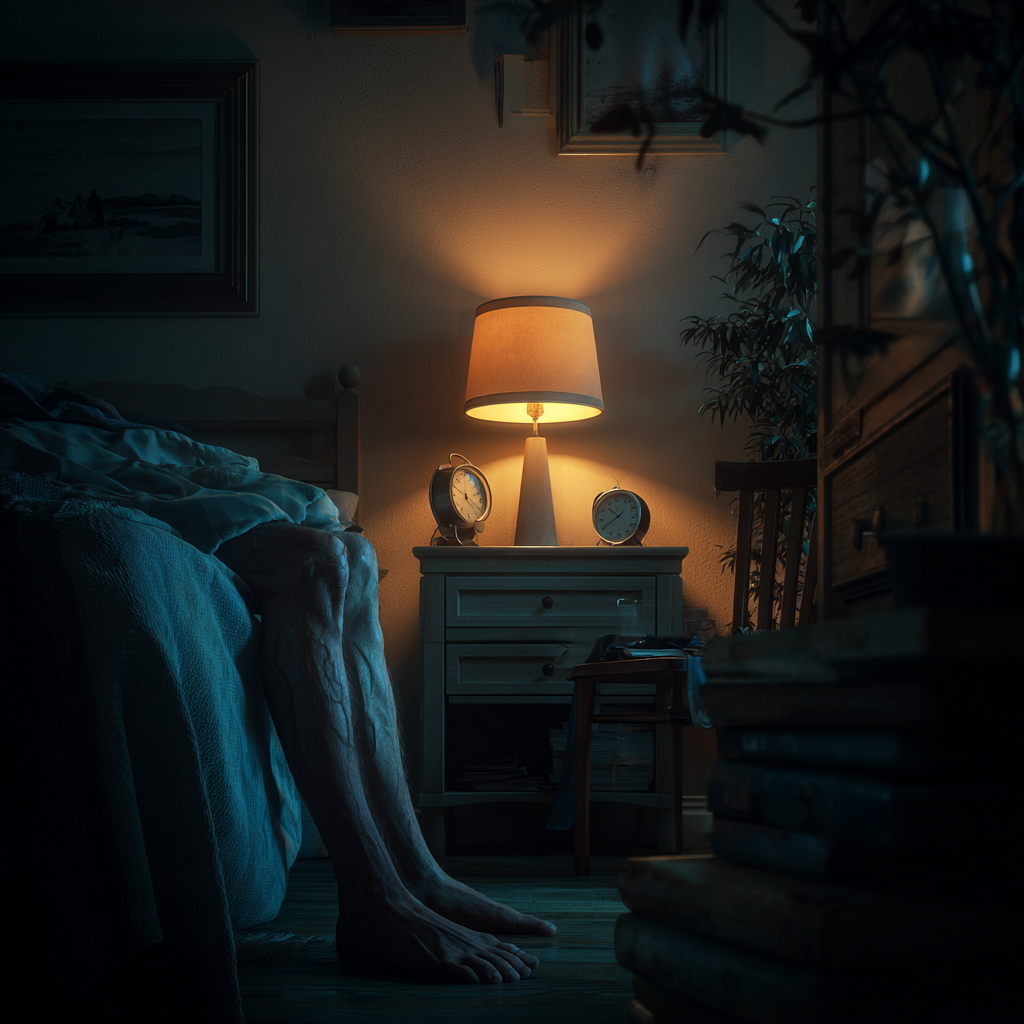When Nighttime Leg Cramps Become a Concern
Waking up in the middle of the night to a stabbing pain in your calf is more common than you might think. Nighttime leg cramps—sudden, involuntary contractions of the muscles, usually in the calves or feet—affect millions of people. Often brushed off as harmless or chalked up to aging or dehydration, these cramps can sometimes be your body’s way of signaling something deeper.
So when should you worry?

The Occasional Cramp: Usually Harmless
Most nighttime leg cramps are benign. They may result from:
- Overuse of muscles during the day
- Dehydration
- Prolonged standing or sitting
- Sleeping with feet in an awkward position
- Electrolyte imbalance (such as low magnesium, potassium, or calcium)
- Pregnancy
For many people, cramps happen now and then, go away with gentle stretching, and don’t return for weeks. But in some cases, these nighttime jolts are more than just an annoyance.
When to Be Concerned
Nighttime leg cramps become a medical concern when they cross certain thresholds:
1. Frequent Occurrence
If you’re experiencing leg cramps more than three nights a week, something may be off. Frequent cramping could be a sign of underlying systemic imbalances, such as poor circulation or nerve issues, especially if they increase over time.
2. Severe Pain or Duration
Most cramps last a few seconds to a few minutes. But if you’re feeling intense pain that won’t ease, or if the muscle stays tight and sore for hours after, this may point to circulatory or neurological problems.
3. Sleep Disturbance
Chronic sleep interruptions from cramps can lead to fatigue, irritability, and even depression. If cramps are robbing you of restful sleep, it’s a sign that medical evaluation is warranted.
4. Accompanied by Other Symptoms
Look for these red flags:
- Muscle weakness during the day
- Swelling in the legs or feet
- Numbness, tingling, or burning sensations
- Dark or tea-colored urine
- Unexplained fatigue
These may indicate conditions such as:
- Peripheral artery disease (PAD)
- Kidney dysfunction
- Diabetes-related nerve damage (neuropathy)
- Electrolyte imbalances
5. Medication Side Effects
Some medications are known to trigger leg cramps, especially:
- Diuretics (often used for high blood pressure or heart disease)
- Statins (cholesterol-lowering drugs)
- Beta blockers
- Certain asthma medications
If your cramps began after starting a new medication, it’s time to check in with your doctor.
6. Age and Underlying Health Conditions
Older adults are more prone to leg cramps, especially those with chronic health issues. If you have diabetes, vascular disease, or thyroid problems, your cramps may be linked to more than just overworked muscles.

What Causes Nighttime Leg Cramps?
Here are the most common underlying factors:
- Dehydration – Reduces blood volume and alters nerve signaling
- Electrolyte Imbalance – A lack of magnesium, potassium, or calcium disrupts muscle function
- Poor Circulation – Reduced blood flow can cause muscles to cramp
- Nerve Compression – Conditions like spinal stenosis can affect nerve signals
- Prolonged Inactivity – Sitting or lying in one position for too long, especially in awkward postures
- Vigorous Exercise – Overexertion without proper recovery can trigger cramping
How to Prevent Nighttime Leg Cramps
Nighttime leg cramps can feel random and frustrating—but in many cases, they’re preventable. Small lifestyle changes and targeted habits can make a big difference in reducing their frequency and severity. Here’s a deeper look at proven ways to protect your sleep from those painful midnight muscle spasms:
1. Stretching Before Bed
A gentle stretching routine before sleep can significantly lower your risk of cramps. Focus on the calves, hamstrings, and feet.
Why it works: Stretching helps lengthen muscle fibers, increases blood flow, and keeps them supple overnight—especially important if you’ve been sitting or inactive for long periods.
Example routine (2–3 minutes):
- Calf stretch: Stand facing a wall, one foot behind the other, front knee bent, back knee straight. Lean into the wall and hold.
- Hamstring stretch:Sit on the edge of your bed, extend one leg, and gently reach for your toes.
- Ankle circles: Rotate each ankle 10 times in both directions.
2. Hydration Matters
One of the most common but overlooked causes of leg cramps is dehydration.
Tip: Drink plenty of water throughout the day—not just at night. Aim for 6–8 glasses of water, or more if you’re physically active or in a hot climate.
Bonus:
3. Replenish Electrolytes
Low levels of magnesium, potassium, calcium, or sodium can cause muscle cramps.
Best sources of electrolytes:
- Magnesium: Pumpkin seeds, almonds, leafy greens, dark chocolate
- Potassium: Bananas, sweet potatoes, oranges
- Calcium: Dairy, tofu, fortified plant milk
- Sodium (carefully): Sea salt, broth-based soups
If you suspect a deficiency, consider supplements—but always consult your doctor first.
4. Move Throughout the Day
Sedentary lifestyle? Sitting or standing for hours without moving? That can make your muscles tighten and cramp later.
Preventive habit:
- Walk or stretch every hour
- Shift positions if you’re seated long-term
- Use a standing desk or footstool to vary leg pressure
Low-impact exercise like walking, swimming, or cycling also promotes healthy circulation

5. Wear Proper Footwear
Supportive shoes matter more than you might think.
Avoid:
- High heels
- Completely flat shoes
- Worn-out insoles
Use:
- Arch-supportive footwear
- Cushioned soles
- Orthotic inserts if recommended
Bad footwear can strain your muscles all day—leading to cramps at night.
6. Check Your Sleeping Position
Surprisingly, the way you sleep can set the stage for cramps.
Avoid:
- Sleeping with feet pointed downward (plantar flexion), which shortens calf muscles
Do this instead:
- Keep your feet in a neutral, flexed position
- Place a pillow under your knees or feet to reduce tension
- Try sleeping on your back with your feet slightly elevated
7. Warm Baths and Massages
Warmth relaxes muscles and improves blood flow.
Try:
- A warm bath with Epsom salts before bed (rich in magnesium)
- Using a heating pad on your legs for 10–15 minutes
- Gently massaging your calves with oil or lotion
Even a few minutes of self-care can significantly reduce nighttime muscle tightness.
8. Limit Alcohol and Caffeine
Both alcohol and caffeine can dehydrate you and interfere with deep sleep.
Solution:
- Cut back on alcohol, especially in the evening
- Switch to herbal teas at night
- Balance every caffeinated drink with a glass of water
9. Monitor Medications
Some prescription drugs are known to increase cramping risk, especially diuretics, statins, and beta-blockers.
What to do:
- Never stop medication on your own
- Ask your doctor if your prescriptions could be contributing
- Explore alternative medications if cramps are persistent and disruptive
10. Try Magnesium Supplements (With Caution)
Magnesium is often recommended for leg cramps, especially in older adults and pregnant women.
Dosage:
- Generally safe at 200–400 mg daily, taken in the evening
- Best taken under supervision to avoid interactions or side effects
Some people report relief within days, while others may take a few weeks to notice improvements.
You Need To Make Your Muscles Sleep-Ready
Preventing nighttime leg cramps means preparing your body for rest—hydrated, relaxed, and properly supported. Just like brushing your teeth, making pre-bed stretching and hydration a daily ritual could help you wake up pain-free.
Against All Odds: The Helicopter Mission That Pulled a Horse from Rising Floodwaters

What began as a routine day in the countryside quickly turned into a scene from a disaster film.
Torrential rains had swollen rivers, turning fields into raging waterways and swallowing roads and farms without warning. Amid the chaos, a remarkable sight caught the eyes of rescue crews scanning the flood from above—
a lone horse, desperately struggling against the surging currents. Time was slipping away, and the question haunting everyone was urgent: could the animal be saved, or would the flood claim yet another life?
A Dire Struggle

The floods had come with relentless force, sweeping through towns and farmland alike. For most, the priority was human survival—but here, an animal faced imminent danger. The horse, exhausted and trapped in the center of the flood, fought the water with every ounce of strength it had. Each second that passed made the mission more urgent, more perilous.
Precision, Courage, and Quick Thinking
A seasoned disaster response team was already on site, trained for emergencies that demanded precision and nerves of steel. Recognizing the immediacy of the situation, they determined that a helicopter rescue offered the best chance of survival. Saving a large animal in such conditions required both skill and bravery: strong winds, torrential rain, and treacherous currents turned the mission into a high-stakes gamble.
Into the Storm
As the helicopter hovered above the raging waters, rescuers were lowered carefully by cable. The horse thrashed, panic evident in every movement, but the team’s calm persistence began to build trust. Slowly, the animal allowed itself to be secured in a specialized harness, designed to lift large livestock safely.
Against the Odds
With the horse secured, the pilot held the helicopter steady, battling gusts and turbulence as the animal was lifted out of the floodwaters.
Below, onlookers watched in tense silence, hearts pounding with every inch of elevation. Finally, the horse touched solid ground, soaked and exhausted but alive. The team’s quick thinking and coordination had turned near-certain tragedy into triumph.
A Beacon of Compassion
The story quickly spread across news outlets and social media, capturing hearts worldwide. For many, the rescue symbolized humanity at its most compassionate—a reminder that even in disaster, every life matters. It also sparked conversations about the role of animals in emergency response plans, highlighting the need to protect pets, livestock, and wildlife alongside human communities.
Conclusion
This extraordinary helicopter operation showed that heroism comes in many forms. With skill, courage, and determination, the team transformed a desperate struggle into a story of hope and resilience. In times of crisis, heroes don’t always wear badges—they sometimes arrive on wings of rotor blades, daring the storm to give life another chance.





